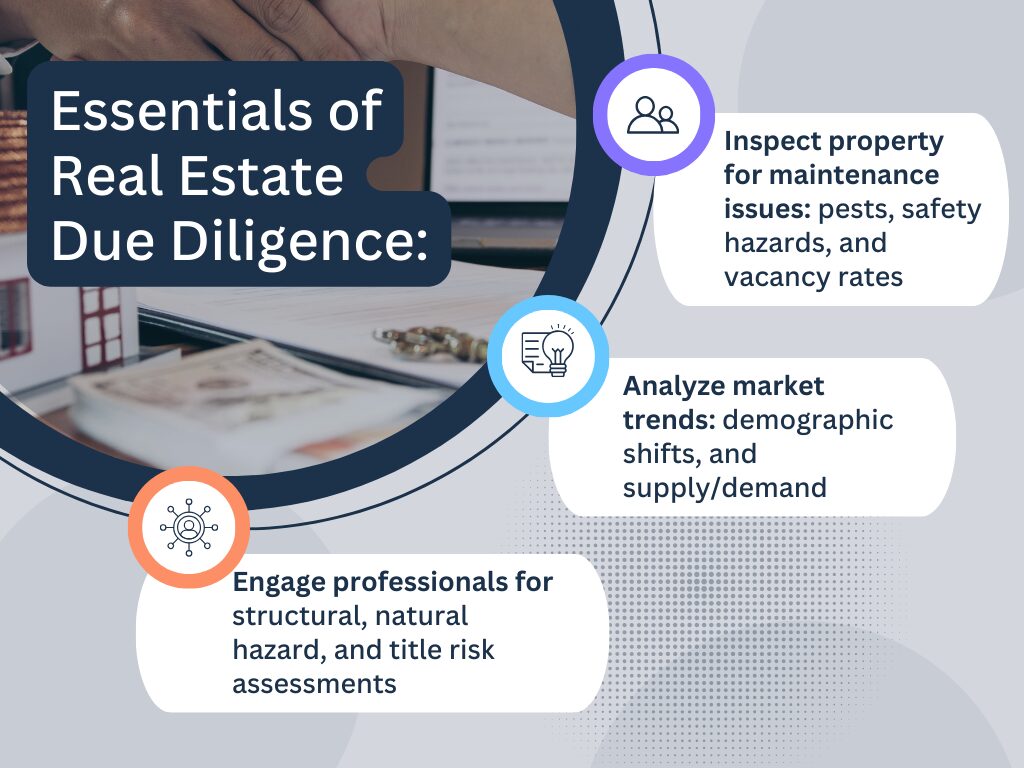Real estate investing offers the potential for attractive returns through rental income and property appreciation. However, it also comes with significant risks that need to be addressed. This article provides property investors essential guidance on identifying, evaluating, and managing major real estate investment hazards.
Conducting Due Diligence is the First Line of Defense
Before committing money to a rental real estate purchase, follow these best practices for conducting thorough due diligence:
Inspect the Property Condition and Assess Vacancy and Maintenance Risks
Carefully examining the physical premises and financial statements is crucial for evaluating potential dangers with the property. Look for:
Signs of deferred maintenance – Peeling exterior paint, cracks in walls/ceilings, water stains, worn carpeting, old appliances/fixtures etc. signal potential issues.
Evidence of pest/vermin infestations or mold risks – Droppings, nesting materials, foul odors, wall discoloration point to pest/vermin problems. Mold signs include musty smells, tile/grout discoloration, warped wood.
Safety hazards and code violations – Faulty or missing GFCI outlets near water sources, lack of carbon monoxide detectors, peeling lead paint, improperly enclosed balconies, malfunctioning smoke alarms etc. violate codes.
High existing vacancy rates – Occupancy below comparable area buildings indicates potential property issues detracting tenants. Also verify if non-renewal notices are given.
Also verify past operating revenues and expenses line-by-line to confirm positive future cash flows.
| Risk Factor | Impact | Mitigation Tips |
|---|---|---|
| Deferred Maintenance | Higher operating & maintenance costs, tenant complaints | Inspect units, common areas, mechanical systems |
| Pests / Vermin | Property damage, health issues, code violations | Check for signs of infestations, address entry points |
| Mold | Tenant health issues, lawsuits, remediation expenses | Inspect for moisture intrusion, leaks, ensure adequate ventilation |
Research Market Cycle Outlook and Risks in Coming Years
Analyze historical property sales and macroeconomic trends to gauge the market cycle risk and appreciation potential:
Local market pricing growth trends – Review historical property price changes in the area. Has annual appreciation been over 5%? How do peaks and dips compare to national averages? This helps gauge future growth potential.
Employment and demographic shifts – If major employers have left or closed, vacancy rates may rise. An influx of younger residents could reduce demand for larger units. Track these indicators in your target area.
Multi-year supply/demand projections – Local real estate reports detail pipeline of planned developments compared to household growth. Big oversupply pipelines signal impending vacancy jumps as new units are completed.
Interest rate environment – Rising rates make financing purchases more expensive, deterring investors and buying groups like first-time homebuyers. Assess Fed forecasts to anticipate rate impacts.
This will help determine the likelihood of market downturns and vacancy spikes in the near-term.
Click here to learn more and subscribe to the newsletter
Have Professionals Evaluate for Other Risk Exposures
Enlist inspectors, lawyers and insurance professionals to assess for additional liabilities:
Structural integrity risks – An inspection by a licensed structural engineer can reveal issues like foundation cracking, shifting walls, compromised beams/supports etc. that threaten the soundness or safety of the building.
Natural hazard risks like floods, earthquakes – Flood zone mapping and geological assessments can gauge the property’s vulnerability to catastrophic weather, seismic, or even wildfire damage.
Title risks – A title report checks for any problems or errors with ownership rights like undisclosed liens, easements/encroachments, pending litigation over rights, claims from heirs etc. The title must have clean ownership.
Getting these evaluations upfront establishes next steps for risk reduction and mitigation.

Careful Planning Can Reduce Vacancy and Property Management Risks
High vacancy rates and poor property management can severely undermine returns. Proven strategies to mitigate these rental property risks include:
Target More Stable Renter Profiles That Stay Longer Term
Analyze demographics and average tenancy terms in the area to identity the most stable renter groups, such as:
– Families tend to change housing less frequently than singles once kids enroll in local schools
– Senior citizens often desire to age in place due to community connections
– Domestic partners usually share housing costs allowing lengthier stays
Marketing specifically to these demographics can improve occupancy rates and reduce unit turnovers.
Get your free “2024 Real Estate Market Outlook” now!
Set Optimal Rents with Smart Pricing Strategies
Conduct competitive rent analysis for comparable nearby units to determine market-supported pricing levels. Ensure your asking rents align with the property’s positioning – a newly upgraded interior may command premium rate versus dated finishes.
Additionally, offer sensible concessions like first month free or waiving fees to securely lease-up remaining vacancies during slower seasons rather than dropping base rents.
Implementing strong rental rate frameworks while incentivizing priority prospects to sign leases is key to maintaining higher occupancy.
Cultivate Referral Networks to Expand Qualified Leads
Developing close relationships with area realtors, employers/HR contacts, apartment listing sites and past satisfied tenants can yield referral pipelines helping fill openings faster through word-of-mouth marketing. Consider:
Realtor partnerships – Co-marketing arrangements sending rental listings to realtors for distribution to their buyer prospects not quite ready for home purchasing. Offers finder’s fees on successful leases.
Corporate relationships – Seek designated rental provider status with large regional employers to tap into major talent pools and facilitate recruitment/relocations.
Tenant advocacy incentives – Motivate your best residents to contribute fresh leads by creating tenant referral reward programs.
Capitalizing on referral networks expands qualified inbound leads and streamlines leasing efforts compared to cold prospecting. The leads come qualified and ready to view/lease.
Conclusion
Mitigating risks across these key areas – extensive due diligence, diversification, vacancy reduction tactics, budgeting for long-term capex needs, and specialized insurance – provides a multilayered defense against the array of hazards within real estate investing. No single strategy eliminates all vulnerabilities. However, by thoroughly assessing your risk exposures, planning for contingencies, and employing proven best practices to address them, real estate investors can invest with greater confidence while still earning attractive risk-adjusted returns over the long run.
The journey starts by acknowledging real estate does entail risks. But through prudent planning and preventative actions, the likelihood and impact of those risks can be diminished substantially. That allows investors to feel assured in putting their capital to work in this historically lucrative asset class while sleeping soundly at night knowing their downsides are covered.
Interested in multifamily real estate investing? Our experienced team is here to help. From market research to identifying the best opportunities, we guide you through the process. Subscribe to our YouTube channel for informative videos and expert discussions, and follow us on Instagram for exclusive content. Explore our comprehensive Udemy course for detailed insights and strategies. Ready to elevate your investment journey? Contact us now to schedule a consultation and achieve your financial goals in real estate.
*This content is for informational purposes only and is not intended as financial or legal advice. Please consult with a professional advisor before making any investment decisions.




























